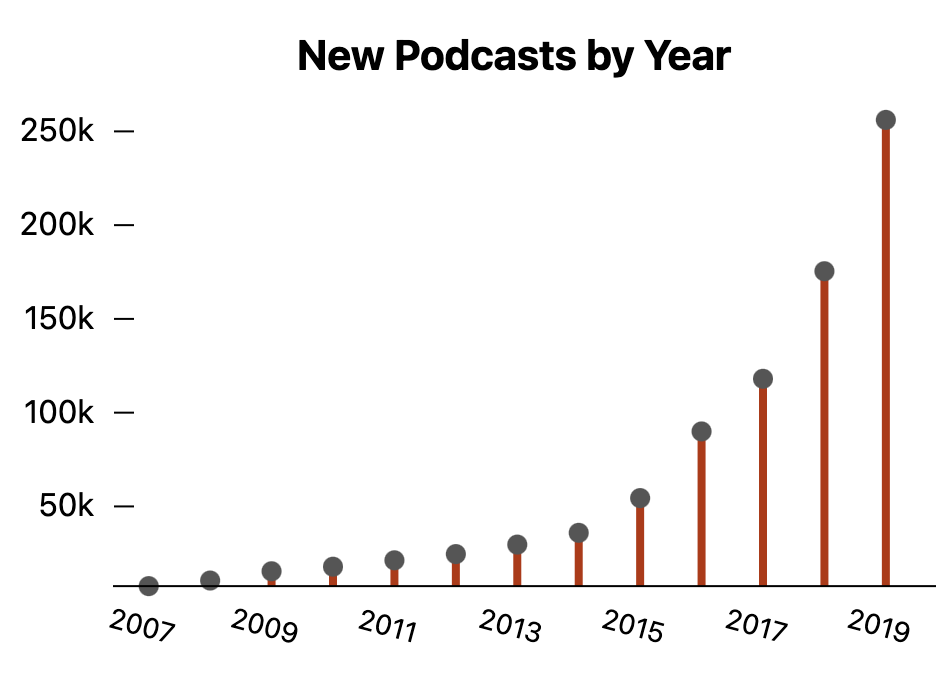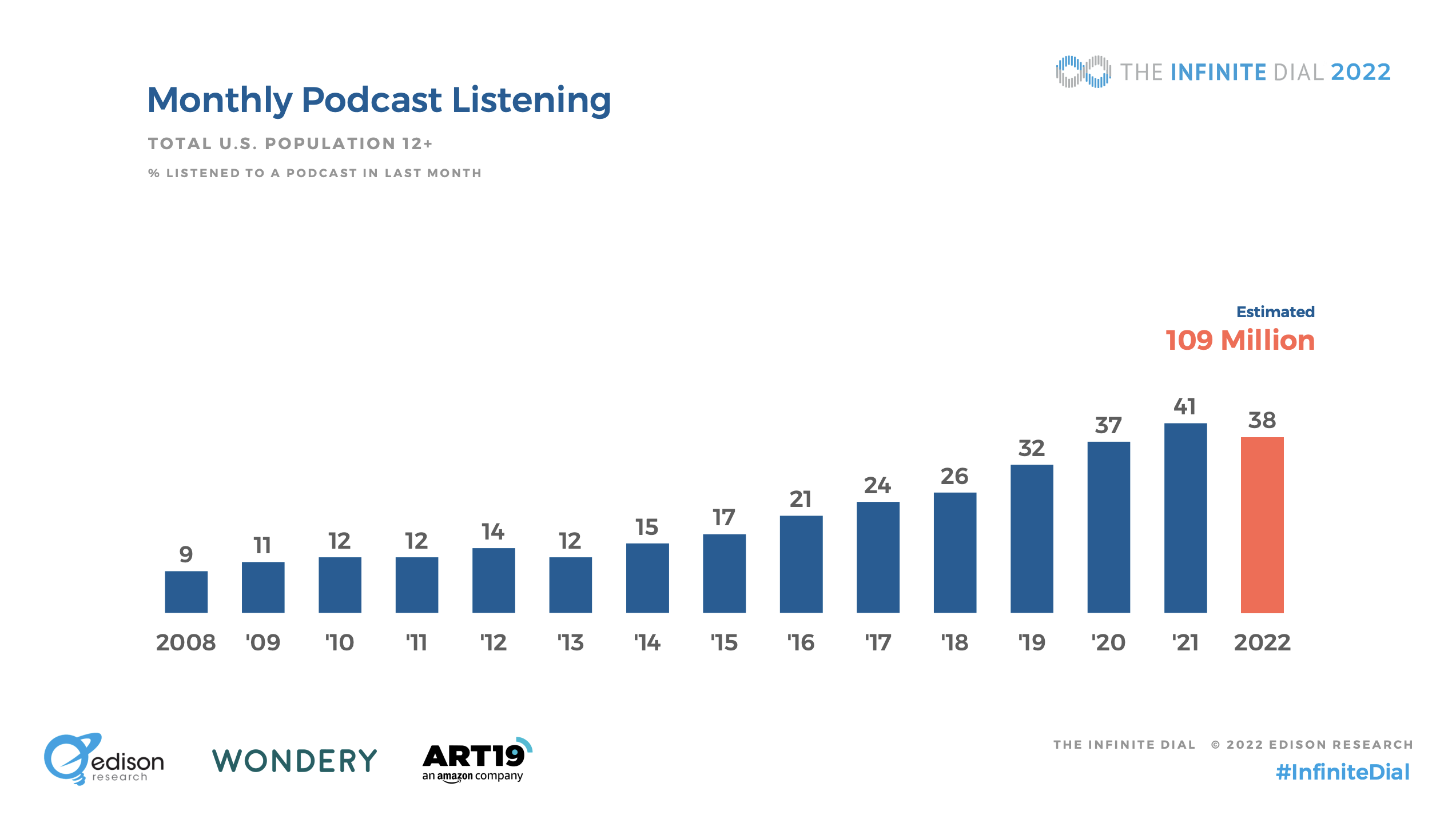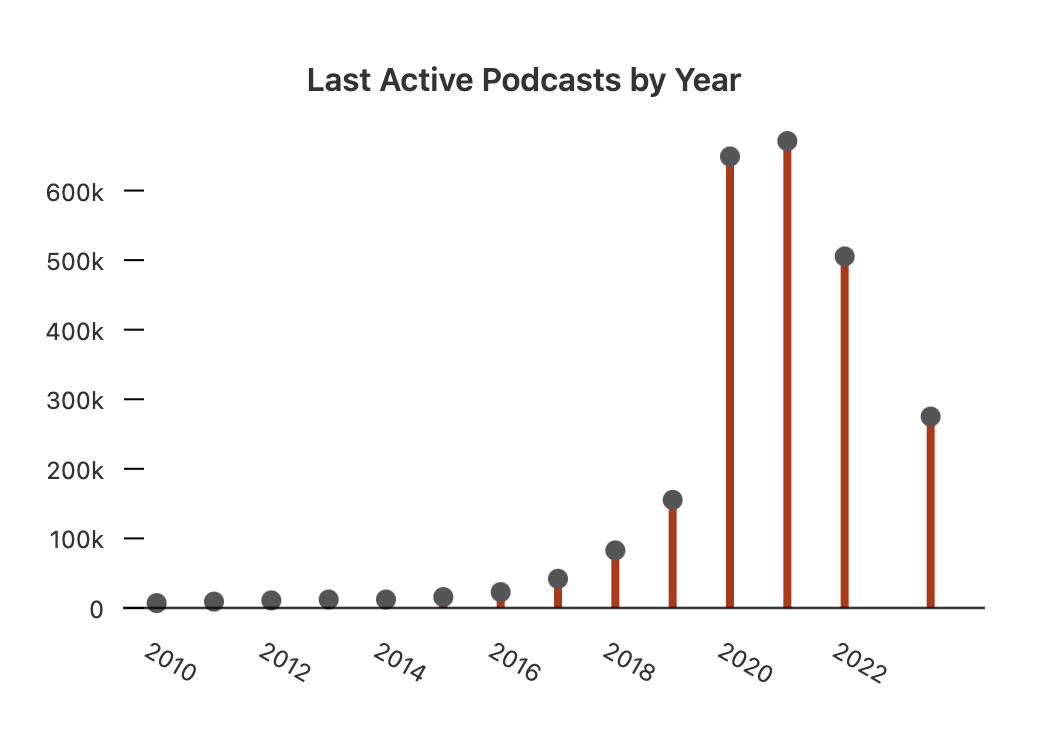
Last week’s edition of Hot Pod contained a statistic so stunning I had to read it twice:
One thing I keep hearing over and over is that it is so much harder to launch a podcast now than it was, say, three or four years ago. And that is usually coming from people at established studios with at least some marketing might. For independent creators, it must be nearly impossible.It is not entirely surprising that, according to data compiled by Chartr from Listen Notes, fewer podcasts were created in 2022 than in the two years prior. Even so, the margin is shocking: the number of new shows created dropped by nearly 80 percent between 2020 and 2022.
That’s right: nearly 80 percent.
To put that into raw numbers (again, the source here is Listen Notes, a podcast search engine): In 2020, 1,109,000 new podcasts were launched. In 2021, that number dropped to 729,000. And in 2022, it cratered to just 219,000.
Here’s what that looks like:1

That chart makes one thing clear: Roughly everyone launched a podcast in the COVID-19 pandemic’s nadir, and a big part of the decline is an aftereffect of that fact. All that time stuck in your house had to be put to use somehow, after all. The 2020-21 spike in cognitive surplus was always destined to recede.
Still…the decline is even detectable within calendar year 2022. There were 67,000 new podcasts launched in Q1, 54,000 in Q2, 53,000 in Q3, and 44,000 in Q4. That’s a drop of one-third in 12 months’ time. (So far in 2023, Listen Notes counts 7,026 new podcasts launched; at that pace, Q1 2023 would decline to less than 30,000 — a more than 50% drop year-over-year. But it’s still too early in the quarter to invest much meaning there.)
This feels…odd. Podcasting has had periods of boom, and it’s had periods of slower growth. But it hasn’t seen anything like this.
For context, here’s what that same chart looked like in January 2020, right when things were getting dicey in Wuhan. The Y-axis is a lot shorter, but the trend line is steady.

Here’s Hot Pod’s Ariel Shapiro on the phenomenon:
Creators seem to recognize that until podcast discovery improves, launching a podcast may be a losing proposition. The system seemingly cannot effectively handle the number of podcasts that already exist.
Until podcast discovery improves. But podcast discovery has been the industry’s defining problem forever. (Here we are calling it “the podcast community’s constant lament” almost a decade ago.) Is there any reason to think we’re closer to Perfect Podcast Discovery in 2023 than we were in 2015? Or, in a far more clogged marketplace, are we farther away than ever?
A steep drop in new podcast creation has implications for the industry — in particular for the news-oriented segment of it, the one we care about most here.
The number of new podcasts may have plummeted, but Listen Notes’ numbers show new episodes hasn’t to the same degree. New episodes were down between 2020 and 2022, but only by 13%.
If the number of new shows is dropping, that by definition impacts short-run podcasts more than shows without a definite ending. That’s bad news for news publishers, who have found success (critical, at least, if not always financial) in that segment.
That eight-episode show re-reporting a decades-old murder in your town? The limited-run show tied to your legislature’s session? Those aren’t editorial machines you set and forget; they’re projects with a beginning and an end. They can make for great journalism — but they also mean finding new audiences at every launch. What the new-show decline suggests is that the market is favoring ongoing shows — and that the ROI on a limited-run podcast is getting lower.
What’s the old Yogi Berra quote? Nobody ever goes there anymore — it’s too crowded. That might be a contradiction if you’re talking about a restaurant or bar — but it seems to be accurate in the podcast-making space, which has become so crowded that fewer people want to enter it.
The concerns aren’t just on the supply side — demand is also a question mark.
Edison Research’s Infinite Dial report is the closest we have to an industry-wide check-in. In 2022, after years of steady growth, the percentage of Americans who said they had listened to a podcast in the past month declined — from 41% to 38%.

Perhaps most troubling, the decline was higher among younger listeners, ages 12-34 — they dropped from 56% to 50% in one year.
Podcasting’s “share of ear” — meaning: Of all the time Americans spend listening to audio, what share of it is spent listening to a podcast? — also dropped overall, from 6% to 5%. And so did weekly listening (from 28% to 26%).
Nothing as dramatic as that 80% drop, to be sure. But if there’s less listening to go around, that will only make it more difficult for new entrants to break through.
Take a look at this chart. It’s looking at all the podcasts Listen Notes considers “active” — but using a very broad definition of “active.” (For a podcast to be “non-active” to Listen Notes, it must have either (a) had its RSS feed removed from the internet or (b) have turned on a <itunes:complete> flag in its RSS, letting Apple and podcast apps know that no more episodes will be published. Given that most dead podcasts are simply abandoned — not formally closed or erased from the internet — “non-active” podcasts are a small fraction of all podcasts.)
For each of these “active” podcasts, the years in the chart represent when its most recent episode was released. So if your Two White Guys Talk Movies pod last put out an ep in 2015, it’d show up here under 2015.

Sum up these numbers and you start to see the scale of podcast death during the pandemic.
Listen Notes counts nearly 2.5 million podcasts as “active.” Of those, only 294,895 have released an episode so far in 2023. But hey, it’s only mid-January — let’s extend that back a bit. A total of 781,833 podcasts have released at least one episode since January 1, 2022 — a period of a little more than 12.5 months. I think this is a group of shows we can fairly consider ongoing concerns. (Sure, some old shows will revive themselves tomorrow with a new episode — but some of the ones we’re counting as still breathing went dark for good months ago.)
What about the shows that are probably dead — the ones who haven’t published any episodes since 2021, or earlier?
There are 369,545 podcasts whose last episode was released between 2010 and 2019 — a full decade. But there are 1,318,646 whose last episode came out in either 2020 or 2021. Those two pandemic years featured a huge number of new podcasts launched, yes — but it also witnessed the death of an unprecedented number of shows.
To put it another way: Of all the podcasts that have stopped publishing since 2010, 78% of them stopped in either 2020 or 2021. The huge spike in creation coincided with a huge spike in destruction.
Look, none of this means that podcasting is dead, or dying. There will still be new shows and new successes. But these numbers suggest that the gold-rush era has been replaced with a mature market.
This happens to all forms of new media, of course. (Remember blogs?) The market gets more crowded; incumbents’ advantages harden; the returns to launching grow less certain. It looks like that’s where a large part of the podcasting business is headed.